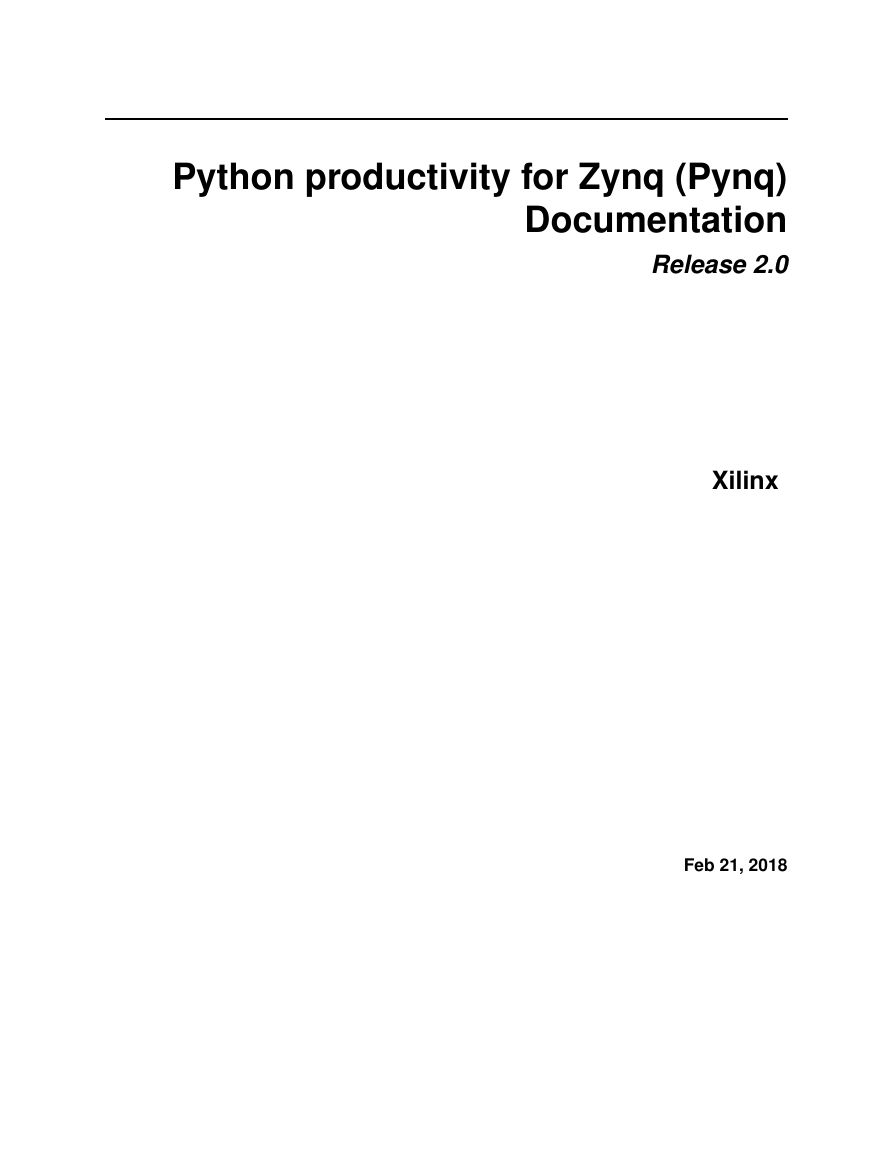Python productivity for Zynq (Pynq)
Documentation
Release 2.0
Xilinx
Feb 21, 2018
�
�
Contents
1 Project Goals
3
2 Summary
.
.
.
.
.
.
.
.
.
.
.
.
.
.
.
.
.
.
.
.
.
Jupyter Notebooks .
Python Environment
.
PYNQ Overlays
PYNQ Libraries
.
5
. . . . . . . . . . . . . . . . . . . . . . . . . . . . . . . . . . . . .
5
.
2.1 Getting Started .
.
. . . . . . . . . . . . . . . . . . . . . . . . . . . . . . . . . . . .
13
.
2.2
.
. . . . . . . . . . . . . . . . . . . . . . . . . . . . . . . . . . . .
24
.
2.3
. . . . . . . . . . . . . . . . . . . . . . . . . . . . . . . . . . . . .
29
.
2.4
. . . . . . . . . . . . . . . . . . . . . . . . . . . . . . . . . . . . .
41
2.5
.
.
. . . . . . . . . . . . . . . . . . . . . . . . . . . . . . . . . . .
68
2.6 Overlay Design Methodology .
. . . . . . . . . . . . . . . . . . . . . . . . . . . . . . . . . . . . . 112
.
2.7
. . . . . . . . . . . . . . . . . . . . . . . . . . . . . . . . . . 114
. . .
.
2.8
2.9 Verification .
.
. . . . . . . . . . . . . . . . . . . . . . . . . . . . . . . . . . . . 201
.
2.10 Frequently Asked Questions (FAQs) . . . . . . . . . . . . . . . . . . . . . . . . . . . . . . . . . . . 205
. . . . . . . . . . . . . . . . . . . . . . . . . . . . . . . . . . . . . 209
2.11 Glossary .
.
. . . . . . . . . . . . . . . . . . . . . . . . . . . . . . . . . . . . 211
.
2.12 Useful Links .
. . . . . . . . . . . . . . . . . . . . . . . . . . . . . . . . . . . . 212
.
2.13 Appendix .
.
2.14 Change Log .
.
. . . . . . . . . . . . . . . . . . . . . . . . . . . . . . . . . . . . 217
PYNQ SD Card .
.
pynq Package .
.
.
.
.
.
.
.
.
.
.
.
.
.
.
.
.
.
.
.
.
.
.
.
.
.
.
.
.
.
.
.
.
.
.
.
.
.
.
.
.
.
.
.
.
.
.
.
.
.
.
.
.
.
.
.
.
.
.
.
.
.
.
.
.
.
.
.
.
Python Module Index
221
i
�
ii
�
Python productivity for Zynq (Pynq) Documentation, Release 2.0
Xilinx® makes Zynq® devices, a class of All Programmable Systems on Chip (APSoC) which integrates a multi-core
processor (Dual-core ARM® Cortex®-A9) and a Field Programmable Gate Array (FPGA) into a single integrated
circuit. FPGA, or programmable logic, and microprocessors are complementary technologies for embedded systems.
Each meets distinct requirements for embedded systems that the other cannot perform as well.
Contents
1
�
Python productivity for Zynq (Pynq) Documentation, Release 2.0
2
Contents
�
CHAPTER 1
Project Goals
The main goal of PYNQ, Python Productivity for Zynq, is to make it easier for designers of embedded systems to
exploit the unique benefits of APSoCs in their applications. Specifically, PYNQ enables architects, engineers and
programmers who design embedded systems to use Zynq APSoCs, without having to use ASIC-style design tools to
design programmable logic circuits.
PYNQ achieves this goal in three ways:
• Programmable logic circuits are presented as hardware libraries called overlays. These overlays are analogous
to software libraries. A software engineer can select the overlay that best matches their application. The overlay
can be accessed through an application programming interface (API). Creating a new overlay still requires
engineers with expertise in designing programmable logic circuits. The key difference however, is the build
once, re-use many times paradigm. Overlays, like software libraries, are designed to be configurable and re-used
as often as possible in many different applications.
Note: This is a familiar approach that borrows from best-practice in the software community. Every day, the Linux
kernel is used by hundreds of thousands of embedded designers. The kernel is developed and maintained by fewer
than one thousand, high-skilled, software architects and engineers. The extensive re-use of the work of a relatively
small number of very talented engineers enables many more software engineers to work at higher levels of abstraction.
Hardware libraries or overlays are inspired by the success of the Linux kernel model in abstracting so many of the
details of low-level, hardware-dependent software.
• PYNQ uses Python for programming both the embedded processors and the overlays. Python is a “productivity-
level” language. To date, C or C++ are the most common, embedded programming languages. In contrast,
Python raises the level of programming abstraction and programmer productivity. These are not mutually-
exclusive choices, however. PYNQ uses CPython which is written in C, and integrates thousands of C libraries
and can be extended with optimized code written in C. Wherever practical, the more productive Python environ-
ment should be used, and whenever efficiency dictates, lower-level C code can be used.
• PYNQ is an open-source project that aims to work on any computing platform and operating system. This goal
is achieved by adopting a web-based architecture, which is also browser agnostic. We incorporate the open-
source Jupyter notebook infrastructure to run an Interactive Python (IPython) kernel and a web server directly
on the ARM Cortex A9 of the Zynq device. The web server brokers access to the kernel via a suite of browser-
3
�
Python productivity for Zynq (Pynq) Documentation, Release 2.0
based tools that provide a dashboard, bash terminal, code editors and Jupyter notebooks. The browser tools are
implemented with a combination of JavaScript, HTML and CSS and run on any modern browser.
4
Chapter 1. Project Goals
�
















 2023年江西萍乡中考道德与法治真题及答案.doc
2023年江西萍乡中考道德与法治真题及答案.doc 2012年重庆南川中考生物真题及答案.doc
2012年重庆南川中考生物真题及答案.doc 2013年江西师范大学地理学综合及文艺理论基础考研真题.doc
2013年江西师范大学地理学综合及文艺理论基础考研真题.doc 2020年四川甘孜小升初语文真题及答案I卷.doc
2020年四川甘孜小升初语文真题及答案I卷.doc 2020年注册岩土工程师专业基础考试真题及答案.doc
2020年注册岩土工程师专业基础考试真题及答案.doc 2023-2024学年福建省厦门市九年级上学期数学月考试题及答案.doc
2023-2024学年福建省厦门市九年级上学期数学月考试题及答案.doc 2021-2022学年辽宁省沈阳市大东区九年级上学期语文期末试题及答案.doc
2021-2022学年辽宁省沈阳市大东区九年级上学期语文期末试题及答案.doc 2022-2023学年北京东城区初三第一学期物理期末试卷及答案.doc
2022-2023学年北京东城区初三第一学期物理期末试卷及答案.doc 2018上半年江西教师资格初中地理学科知识与教学能力真题及答案.doc
2018上半年江西教师资格初中地理学科知识与教学能力真题及答案.doc 2012年河北国家公务员申论考试真题及答案-省级.doc
2012年河北国家公务员申论考试真题及答案-省级.doc 2020-2021学年江苏省扬州市江都区邵樊片九年级上学期数学第一次质量检测试题及答案.doc
2020-2021学年江苏省扬州市江都区邵樊片九年级上学期数学第一次质量检测试题及答案.doc 2022下半年黑龙江教师资格证中学综合素质真题及答案.doc
2022下半年黑龙江教师资格证中学综合素质真题及答案.doc